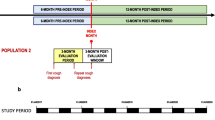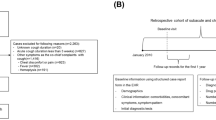Abstract
Objectives: To determine the risk of coughing as an adverse reaction to ACE inhibitors under everyday circumstances in a large population, and to study whether this adverse effect was duration or dose dependent.
Design: A population-based case-control study.
Setting: Ten general practices of 14 Dutch general practitioners (GP), in which all consultations, morbidity and medical interventions, including drugs prescribed, were registered over the 18 month period from 1st September, 1992 to 1st March, 1994.
Subjects: 1458 patients with incident coughing and up to four controls per case were obtained (total 4182 controls), matched for GP. All cases and controls were 20 years or older and had no record of respiratory infection, influenza, tuberculosis, asthma, chronic bronchitis, emphysema, congestive heart failure, sinusitis, laryngitis, haemoptysis or respiratory neoplasms during the study period.
Results: Cases were 2.1-times more likely than controls to have been exposed to ACE inhibitors (95% CI 1.5–3.1), but after adjustment the odds ratio was 1.4 (95% CI 0.9–2.1). The crude odds ratio for captopril was 1.3 (95% CI 0.7–2.5), for enalapril 2.6 (95% CI 1.6–4.2) and for lisinopril 2.0 (95% CI 0.5–9.3). The adjusted odds ratio for captopril was 0.9 (95% CI 0.4–1.7), for enalapril 1.7 (95% CI 1.03–2.8) and for lisinopril 1.7 (95% CI 0.4–7.9). For patients who had been on ACE inhibitor treatment for no longer than 2 months the odds ratio was 4.8 (95% CI 1.7–13.3). The odds ratio declined to 2.0 (95% CI 1.1–3.8) for those who had taken an ACE inhibitor for 2–6 months, and to 1.6 (95% CI 0.9–2.7) for those on ACE-inhibitors for more than 6 months.
Conclusion: The risk of coughing was increased twofold among ACE inhibitor users, but the odds ratios were no longer significant after controlling for several confounding factors. The risk of developing cough due to ACE-inhibitors declines with the duration of treatment, possibly due to depletion of susceptible persons.
Similar content being viewed by others
References
Havelka J, Vetter H, Studer A, Greminger P, Luscher T, Wollnik S, Siegenthaler W, Vetter W (1982) Acute and chronic effects of Angiotensin-Converting Enzyme Inhibitor Captopril in Severe Hypertension. Am J Cardiol 49:1467–1474
Sesoko S, Kaneko Y (1985) Cough associated with the use of captopril. Arch Intern Med 145:1524
Israili ZH, Hall WD (1992) Cough and angioneurotic edema associated with angiotensin-converting enzyme inhibitor therapy. A review of the literature and pathophysiology. Ann Intern Med 117:234–242
Inman WHW (1986) Enalapril-induced cough Lancet 2:1218
Coulter DM, Edwards IR (1987) Cough associated with captopril and enalapril. BMJ 294:1521–1523
Yeo WW, Ramsey LE (1990) Persistent dry cough with enalapril: incidence depends on method used. J Hum Hypertens 4:517–520
Stoller JK, Elghazawi A, Mehta AC, Vidt DG (1988) Captopril-induced cough. Chest 93:659–661
Webb D, Benjamin N, Collier J, Robinson B (1986) Enalapril-induced cough. Lancet 2:1094
Kaufman J, Casanova JE, Riendl P, Schlueter DP (1989) Bronchial hyperreactivity and cough due to angiotensin-converting enzyme inhibitors. Chest 95:544–548
Hume AL, Murphy JL, Lauerman SE (1989) Angiotensin-converting enzyme inhibitor-induced cough. Pharmacotherapy 9:88–90
Morice AH, Brown MJ, Higenbottam T (1989) Cough Associated with Angiotensin Converting Enzyme Inhibition. J Cardiovasc Pharmacol 13 [Suppl 3]:S59-S62
McEwan JR, Choudry N, Street R, Fuller RW (1989) Change in cough reflex after treatment with enalapril and ramipril. BMJ 299:13–16
Yeo WW, Foster G, Ramsay LE (1991) Prevalence of persistent cough during long-term enalapril treatment: controlled study versus nifedipine. Q J Med 80: 763–770
Poole MD, Postma DS (1991) Characterization of cough associated with angiotensin converting enzyme inhibitors. Otolaryngol Head Neck Surg 105:714–716
Yeo WW, Maclean D, Richardson PJ, Ramsey LE (1991) Cough and enalapril: assessment by spontaneous reporting and visual analogue scale under double-blind conditions. Br J Clin Pharmacol 31:356–359
Os I, Bratland B, Dahlof B, Gisholt K, Syvertsen JO, Tretli S (1992) Female sex as an important determinant of lisinopril-induced cough. Lancet 339:372
Strocchi E, Valtancoli, G, Ambrosioni E (1989) The incidence of cough during treatment with angiotensin converting enzyme inhibitors. J Hypertens 7 [Suppl 6]:S308-S309
Moore N, Noblet C, Joannides R, Ollagnier M, Imbs JL, Lagier G (1993) Cough and ACE inhibitors. Lancet 341:61
Lefebvre J, Poirier L, Lacourciere Y (1992) Prospective trial on captropril-related cough. Ann Pharmacother 26:161–164
Carre A, Vasmant D, Elmalem J, Thiery P (1991) Tolerability of ramipril in a multicenter study of mild-to-moderate hypertension in general practice. J Cardiovasc Pharmacol 18 [suppl 2]:S141-S143
Strocchi E, Valtancoli G, Ricci C, Malini PL, Bassein L, Ambrosioni E (1992) Postmarketing studies of subjective side effects; a case for strict methodological criteria and careful analysis of data. Pharmacol Res 25 [Suppl 1]:79–80
Visser LE, Stricker BHCh, Van der Velden J, Paes AHP, Bakker A (1995) ACE-inhibitor associated cough: a population-based case-control study. J Clin Epidemiol 48:851–857
Inman WHW, Rawson NSB, Wilton LV, Pearce GL, Speirs CJ (1988) Postmarketing Surveillance of enalapril. 1: Results of Prescription Event-Monitoring. BMJ 297:286–289
Cooper WD, Sheldon D, Brown D, Kimber GR, Isitt VL, Currie WJ (1987) Post-marketing surveillance of enalapril: experience in 11,710 hypertensive patients in general practice. J R Coll Gen Pract 37:346–349
Van der Lei J, Duisterhout JS, Westerhof HP, Van der Does E Cromme PVM, Boon WM, Van Bemmel JH (1993) The introduction of computer-based patient records in the Netherlands. Ann Int Med 119:1036–1041
Lamberts H, Woods M (1987) International classification of primary care. Oxford University Press, Oxford
Anonymous. (1987) Anatomical therapeutic chemical (ATC) index: Including defined daily doses (DDD) for plain substances. World Health Organization. Oslo
Puolijoki HJ, Nieminen MM, Siitonen LO, Lahdensuo AH, Reinikainen PM (1989) Is a simultaneous beta-blocker therapy a risk factor for enalapril-induced cough? Respiration 55:127–128
Kamei J, Kasuya Y (1992) The effect of hydrochlorothiazide on the enhanced coughing associated with treatment with enalapril. Eur J Pharmacol 213:137–139
Fogari R, Zoppi A, Tettamanti F, Malamani GD, Tinelli C, Salvetti A (1992) Effects of nifedipine and indomethacin on cough induced by angtiotensin converting enzyme inhibitors: a double-blind radomized, cross-over study, J Cardiovasc Pharmacol 19:670–673
Kleinbaum DG, Kupper LL, Muller KE (1988) Applied regression analysis and other multivariate methods. PWS-Kent Publishing Company, Boston
Egret. ⊠ Statistics and Epidemiology Research Corporation, Seattle, WA.
Just PM (1989) The positive association of cough with angiotensin-converting enzyme inhibitors. Pharmacotherapy 9:82–87
Sebastian JL, Mc Kinney WP, Kaufman J, Young MJ (1991) Angiotensin converting enzyme inhibitors and cough. Chest 99:36–39
Author information
Authors and Affiliations
Rights and permissions
About this article
Cite this article
Visser, L.E., Stricker, B.H.C., Vlug, A.E. et al. Cough due to ace inhibitors: a case-control study using automated general practice data. Eur J Clin Pharmacol 49, 439–444 (1996). https://doi.org/10.1007/BF00195928
Received:
Accepted:
Issue Date:
DOI: https://doi.org/10.1007/BF00195928




